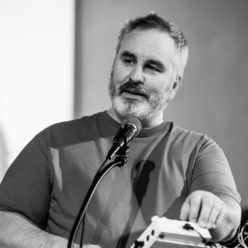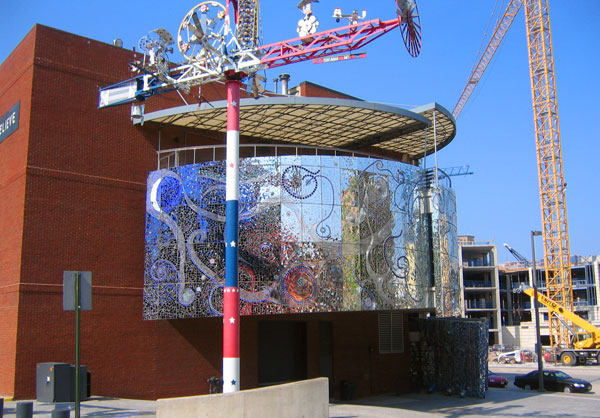About my artwork—
I didn’t set out to get into the visual arts. My college degree is in poetry, my career path has meandered from the grey world of high security government subcontract information work to more grey high security government subcontract work to independent consulting work to street theater to arts administration to…well, it’s been a journey.
What I have done consistently since 1998 is to always, always answer the red hotline when the American Visionary Art Museum calls. I’ve worked for them as a disco-dancing monk, an art handler, an exhibition installer, a technical consultant, an interactive artwork troubleshooter, a further disco-dancing nun, a DJ, an installation artist, an MC, a pastor overseeing a wedding of robots, a…well, it’s the Visionary. You’re going to be asked to do some interesting things.
So when they called me up in 2006, asking if I’d be interested in being the technical engineer for the newest phase in their community art project encrusting the museum facility with the largest installed mosaic in the country, I said “yep.” I’d been working as a technical consultant, technical writer, and contractor, which was paying the bills, but the American Visionary Art Museum satisfies the soul, so I signed on for the year-long project.
The lead artist and community educator was Mari Gardner, a talented artist working in at-risk communities in the Baltimore area, and she and I worked closely to examine the original Phase I mosaic, on the Key Highway side of the museum building, to carry on the successful techniques of the first phase of the project and to introduce new techniques to ensure the longevity of the artwork, based in part on my experience as a media archivist with a special interest in material durability. The project began, we assembled a great team of interns and paid staff, and Mari did the outreach to bring in a number of groups working with young people in drug treatment, post-incarceration, and related fields to work on the project.
In the end, we came in on time and under budget, with a glittering new work to share the museum’s distinct vision with the city of Baltimore, and were part of the rehabilitation of young people who might otherwise have been left out of the fabric of the city they inhabit. It was a joy to be involved, and I ended up learning the process of mosaic art on a visceral, everyday level.
At the end of the project, I felt a great sense of satisfaction, which was made even better when the museum offered me the position of facility manager, replacing their beloved former head of facility, who was retiring. I figured that I was on to my next career development, and that was a good thing, but I’d gotten the mosaic bug, and kept at it. By the time they asked me if I’d be interested in teaching mosaic as a part of the museum’s youth summer camp program, I was ready, and naturally, I said “yep.”
I’ve been working at it ever since, teaching mosaic, building community arts projects in concert with groups like Child First Authority, Inc., the Howard County Arts Council, the American Visionary Arts Museum, and the Howard County Office on Aging and Independence, and, lately, working on solo mosaic artwork to sell as a project to raise funds for my performance touring. Granted, it’s not my first venture, as I’d built interactive sound installation work for the museum as long ago as 1999, and done similar work for the artist Mars Tokyo‘s installations, but this recent venture into the visual arts is an unexpected turn that’s placed me on a wonderful path, and there’s no better way to start a day than with a cup of bitterly dark espresso and a few concentrated minutes spent cutting and placing glass on a new mosaic.
At some point, I’ll get the photographs and notes together to write up a detailed narrative about the project at the museum, because it was a heck of a year and a project that I’d love to see become an inspiration for other institutions and facilities. In the meantime, I’ll keep working small…for now.





